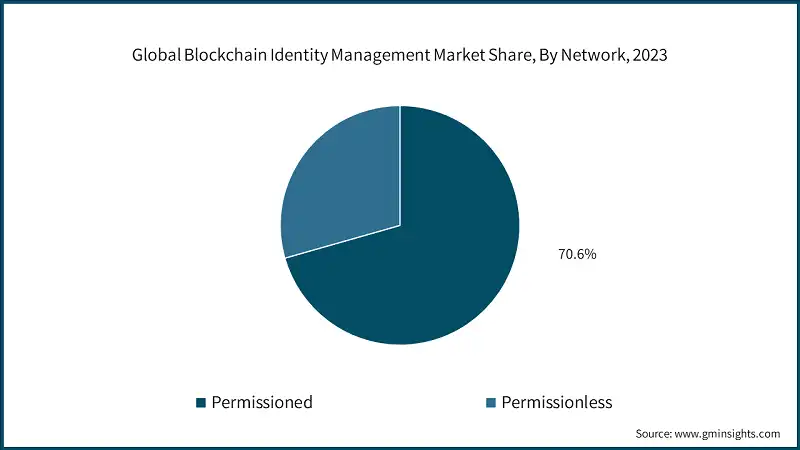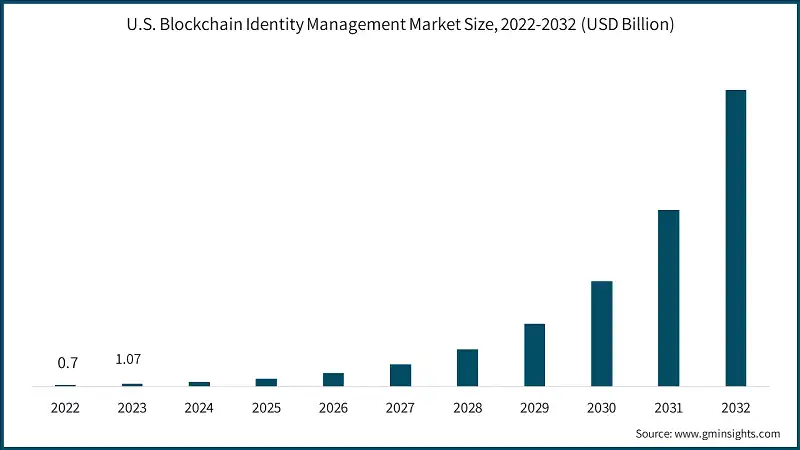News
Blockchain Identity Management Market Size, 2032 Report

Blockchain Identity Management Market Size
Blockchain Identity Management Market was valued at USD 3.38 billion in 2023 and is expected to grow at a CAGR of over 50% between 2024 and 2032. One of the key factors driving the market growth is support from significant technological companies. Prominent technology corporations including Microsoft, IBM, and Oracle are making substantial investments in the creation and implementation of identity management solutions based on blockchain technology. These businesses contribute enormous resources, cutting-edge technological know-how, and significant market power, all of which hasten the development and uptake of these solutions. Companies raise the profile and legitimacy of blockchain identity management by incorporating it into their platforms and product offerings.
The blockchain identity management market is also being driven by the expansion of digital transformation projects in many industries. Identity management solutions must be safe, effective, and dependable as more companies and organizations move their operations online. Blockchain technology is a desirable alternative for businesses going through a digital transition as it provides a decentralized & unchangeable solution that improves the security and integrity of digital identities. As digital transformation continues to accelerate, the demand for blockchain-based identity management solutions is expected to rise, driving significant growth in this market.
| 2023 |
| USD 3.38 Billion |
| 2024-2032 |
| 50% |
| USD 160 Billion |
| 2021-2023 |
| 280 |
| 366 |
| By Offering, Provider Type, Network, Enterprise Size, Industry Vertical, and Region |
|
|
A major challenge for the blockchain identity management sector is integration with older systems. An established IT infrastructure that has been developed and refined over many years powers many enterprises. As these older systems frequently depend on conventional & centralized identity management systems, switching to a decentralized blockchain-based strategy will need significant technical know-how and resources. Certain current systems may not be built to communicate with blockchain technology, leading to compatibility problems.
The market also faces issues with data migration, which call for meticulous preparation and implementation to guarantee the correct and secure transfer of identity data to the new system. To manage and run the new blockchain-based identification systems, personnel often need to undergo considerable retraining, which raises the expenses and complexity even further. These difficulties with assimilation can slow down the adoption of blockchain identity management as organizations may be reluctant to disrupt their established processes and systems.
Blockchain Identity Management Market Trends
The growing use of Self-sovereign Identification (SSI) frameworks is one of the main growth trends in the blockchain identity management industry. By eliminating the need for centralized authorities, SSI gives people the ability to own, control, and govern their digital identities. This method makes use of blockchain technology to give users safe, tamper-proof, and verifiable identities that they can use on various platforms and services. The shift toward SSI is driven by increased concerns over data privacy and security, as well as the demand for more user-centric identity management systems. By giving consumers complete control over their personal data, SSI lowers the dangers related to identity theft and data breaches. As legal frameworks change to emphasize user privacy and data protection, SSI framework use is anticipated to increase.
The growing integration of blockchain identity management systems with enterprise systems is another significant trend. Big businesses are realizing how blockchain technology may improve security, lower fraud, and expedite identity verification procedures. By combining blockchain-based identity solutions with current IT infrastructure, organizations may achieve improved levels of data accuracy, transparency, and efficiency. This integration is particularly essential in industries such as finance, healthcare, and supply-chain management, where safe and trustworthy identity verification is critical. Additionally, blockchain technology makes it easier to comply with strict legal standards, which attracts businesses trying to strengthen their security posture. The market is anticipated to develop significantly as more businesses implement blockchain identity management solutions.
The market for blockchain identity management is being shaped by the emphasis on creating and implementing interoperability standards. Interoperability guarantees the smooth operation of various identity systems based on blockchain, resulting in a unified and intuitive user experience. Verifiable Credentials (VCs) and Decentralized Identifiers (DIDs) are two examples of standards that industry consortia and standardization organizations, such as the World Wide Web Consortium (W3C) and the Blockchain identity management Foundation (DIF), are actively striving to create and promote. These standards are essential for the widespread adoption of blockchain identity management solutions, as they enable interoperability across various platforms and ecosystems. The creation of these standards supports innovations, ensures interoperability, and promotes trust in blockchain-based identification solutions, driving industry growth.
Blockchain Identity Management Market Analysis

Based on offering, the market is divided into software & service. The service segment is expected to register a CAGR of 55% during 2024 and 2032.
- A variety of expert services supporting the deployment, integration, and upkeep of blockchain-based identification solutions are included in the service section of the blockchain identity management market. This covers managed services, custom development, system integration, and consultancy.
- The need for specialist knowledge to help enterprises navigate the complex world of identity management and blockchain technology is growing as more companies implement blockchain identity management systems. Consulting services assist businesses in formulating plans, organizing implementations, and comprehending the possible advantages and difficulties of blockchain identification solutions.
- System integration services guarantee that applications and IT infrastructure currently in use can communicate with blockchain identity systems without any problems. Custom development services create solutions that are specifically built to meet the demands of an organization. The demand for these professional services is rising as more businesses recognize the value of blockchain identity management and seek to leverage its capabilities while ensuring a smooth transition and sustained performance.

Based on network, the market is divided into permissioned & permissionless. In 2032, the permissioned segment dominated the global market with a revenue of over USD 110 billion.
- The permissioned segment comprises systems where access to the blockchain network is limited to a predetermined group of participants. Permissioned blockchains are more controllable over network participation than public blockchains, which makes them especially appealing to businesses and organizations with strict security, privacy, and compliance requirements. Permissioned blockchains allow enterprises to create trusted environments for identity management, allowing identity data to be safely transferred and validated among known entities.
- As participants are screened and given authorization, this technique lowers the risk of unwanted access and data breaches. Among the leading users of permissioned blockchain identification systems are financial institutions, healthcare providers, and governmental organizations.
- The ability to maintain control over the network while benefiting from the decentralized nature of blockchain technology drives the segmental growth.

North America dominated the global blockchain identity management market in 2023, accounting for a share of over 35%. The region’s market is expanding rapidly due to regulatory changes, technological advancements, and the need for safe identification solutions. With prominent IT firms, such as Microsoft, IBM, and Oracle, setting the standard for creating and implementing blockchain-based identity management solutions, the U.S. is leading the way in this sector. These businesses are using blockchain technology to improve identity verification procedures, lower fraud, and safeguard data. By highlighting the significance of data protection and user privacy, regulatory frameworks, such as the California Consumer Privacy Act (CCPA), and ongoing negotiations about a federal data privacy law are fostering a climate that is conducive to the adoption of these technologies.
The region’s robust digital adoption rates, rising cybersecurity concerns, and robust technological infrastructure are all contributing to the growth of the blockchain identity management market in North America. Blockchain-based technology is projected to witness increasing demand as local governments and enterprises look for more effective & safe identity management systems.
The market for blockchain identity management is expanding rapidly in the U.S. owing to a strong focus on privacy, data security, and regulatory compliance. Decentralized identification solutions are finding appeal in the U.S. regulatory environment, which is defined by laws such as the California Consumer Privacy Act (CCPA) and current negotiations about a federal data privacy framework. Furthermore, the U.S. boasts a thriving technology ecosystem that includes a high concentration of startups and innovation hubs, which promotes the creation and application of state-of-the-art blockchain identity solutions. The growing frequency of cyberattacks is driving the need for secure digital identity systems.
The market for blockchain identity management is expanding in Japan as the nation strengthens its cybersecurity protocols and develops its attempts at digital transformation. The Japanese government has taken the lead in advancing blockchain technology through programs such as the Society 5.0 vision, which aims to incorporate cutting-edge technologies into every facet of society. The creation of effective and safe digital identity solutions is a part of this progressive strategy. To increase security and streamline processes, many Japanese firms are investigating and implementing blockchain-based identity management, especially in the financial services and manufacturing industries. In addition, the Financial Services Agency (FSA) and other organizations are striving to create rules to facilitate the adoption of these technologies, and Japan’s regulatory landscape is changing to promote this development. The public & private sectors’ cooperative efforts are also a factor in the establishment of standardized frameworks for decentralized identity, which are also expected to drive blockchain identity management market growth.
South Korea’s outstanding technological infrastructure and strong government support for blockchain initiatives are helping it emerge as a major participant in the blockchain identity management sector. The South Korean government has started several initiatives and legislative initiatives to encourage the adoption of blockchain technology including decentralized identification systems. The active promotion of a blockchain-friendly environment by the Ministry of Science and ICT is also notable. Leading South Korean tech firms, including LG and Samsung, are enhancing security and privacy in their goods and services by investing in blockchain identity management solutions. Several firms are creating novel applications for decentralized identification. South Korean firms and consumers are quickly embracing digital adoption, which further supports the market growth, positioning the country as a leader in this emerging field.
China’s strategy for entering the blockchain identity management market is distinguished by a large investment in blockchain technology and strong government support. Through several programs & regulations, the Chinese government is aggressively fostering the development of blockchain technology, having recognized it as a strategic priority. Decentralized identification solutions are being investigated by state-backed programs to improve the security and effectiveness of digital transactions and public services. With the goal of incorporating these solutions into their vast digital ecosystems, Chinese IT behemoths, such as Tencent and Alibaba, are making significant investments in blockchain and decentralized identification technology. However, there are difficulties and challenges for the adoption of blockchain identity management solutions due to China’s legal framework, which includes strict data management and cybersecurity rules.
Blockchain Identity Management Market Share
Microsoft and IBM held a significant share of over 10% in the blockchain identity management industry. Owing to its strategic blockchain technology investments and strong cloud infrastructure, Microsoft has a substantial market share in the blockchain identity management space. Businesses can create and administer blockchain networks with ease with Microsoft’s Azure platform, which offers a wide range of blockchain services, including Azure Blockchain Service. Microsoft’s Identity Overlay Network (ION), created on the Bitcoin blockchain, offers a Decentralized Identity (DID) solution that improves security and gives users control over personal data. Microsoft’s robust reputation for security and compliance, along with its large enterprise customer base, reinforces its market leadership. By incorporating decentralized identification solutions into the widely used Azure Active Directory (Azure AD) from Microsoft, enterprises may seamlessly shift to blockchain-based identity management while utilizing their current Microsoft infrastructure and technology.
IBM’s deep industry expertise and complete blockchain platform have enabled it to develop a substantial position in the blockchain identity management sector. Blockchain-based identity management solutions can be developed & implemented in a stable environment with IBM Blockchain, a component of the IBM Cloud. With several noteworthy initiatives and partnerships in a range of sectors, such as supply chain, healthcare, and finance, IBM has been a leader in blockchain technology. The company’s blockchain identification solutions, such as IBM Verify Credentials, which make use of the Hyperledger Fabric infrastructure, provide secure & scalable identity verification. For businesses wishing to deploy blockchain identity management, IBM is a reliable partner owing to its strong emphasis on enterprise solutions and in-depth knowledge of legal and compliance needs.
Blockchain Identity Management Market
Major players operating in the blockchain identity management industry are:
- Microsoft
- IBM
- Oracle
- Bitfury
- Metadium Technology Inc.
- Serto
- NuID Inc.
Blockchain Identity Management Industry News
- In January 2023, AWS partnered with Ava Labs to promote the use of blockchain technology in organizations, governments, and businesses. The main goals of this partnership were to strengthen the Avalanche network’s architecture, support the Decentralized Application (dApp) ecosystem, and streamline the deployment and maintenance of nodes on the network.
- In November 2022, K2 Integrity, a risk, compliance, investigations, and monitoring company, partnered with TRM Labs. Through the integration of TRM Labs’ premier blockchain forensics and compliance tools with K2 Integrity’s extensive knowledge of risk management, investigations, and compliance advisory, the partnership allowed both companies to educate institutions and public sector authorities about the risks associated with virtual assets and help them develop strategies to mitigate those risks.
This blockchain identity management market research report includes in-depth coverage of the industry with estimates & forecasts in terms of revenue (USD billion) from 2021 to 2032, for the following segments:
Click here to Buy Section of this Report
Market, By Offering
Market, By Provider Type
- Application provider
- Middleware provider
- Infrastructure provider
Market, By Network
- Permissioned
- Permissionless
Market, By Enterprise Size
- Large enterprises
- Small and medium-sized enterprises
Market, By Industry Vertical
- BFSI
- Retail & e-commerce
- IT & telecommunication
- Government & public sector
- Healthcare
- Manufacturing
- Media & entertainment
- Others
The above information is provided for the following regions and countries:
- North America
- Europe
- Germany
- UK
- France
- Italy
- Spain
- Rest of Europe
- Asia Pacific
- China
- India
- Japan
- South Korea
- ANZ
- Rest of Asia Pacific
- Latin America
- Brazil
- Mexico
- Rest of Latin America
- MEA
- UAE
- Saudi Arabia
- South Africa
- Rest of MEA
News
An enhanced consensus algorithm for blockchain

The introduction of the link and reputation evaluation concepts aims to improve the stability and security of the consensus mechanism, decrease the likelihood of malicious nodes joining the consensus, and increase the reliability of the selected consensus nodes.
The link model structure based on joint action
Through the LINK between nodes, all the LINK nodes engage in consistent activities during the operation of the consensus mechanism. The reputation evaluation mechanism evaluates the trustworthiness of nodes based on their historical activity status throughout the entire blockchain. The essence of LINK is to drive inactive nodes to participate in system activities through active nodes. During the stage of selecting leader nodes, nodes are selected through self-recommendation, and the reputation evaluation of candidate nodes and their LINK nodes must be qualified. The top 5 nodes of the total nodes are elected as leader nodes through voting, and the nodes in their LINK status are candidate nodes. In the event that the leader node goes down, the responsibility of the leader node is transferred to the nodes in its LINK through the view-change. The LINK connection algorithm used in this study is shown in Table 2, where LINKm is the linked group and LINKP is the percentage of linked nodes.
Table 2 LINK connection algorithm.
Node type
This paper presents a classification of nodes in a blockchain system based on their functionalities. The nodes are divided into three categories: leader nodes (LNs), follower nodes (FNs), and general nodes (Ns). The leader nodes (LNs) are responsible for producing blocks and are elected through voting by general nodes. The follower nodes (FNs) are nodes that are linked to leader nodes (LNs) through the LINK mechanism and are responsible for validating blocks. General nodes (N) have the ability to broadcast and disseminate information, participate in elections, and vote. The primary purpose of the LINK mechanism is to act in combination. When nodes are in the LINK, there is a distinction between the master and slave nodes, and there is a limit to the number of nodes in the LINK group (NP = {n1, nf1, nf2 ……,nfn}). As the largest proportion of nodes in the system, general nodes (N) have the right to vote and be elected. In contrast, leader nodes (LNs) and follower nodes (FNs) do not possess this right. This rule reduces the likelihood of a single node dominating the block. When the system needs to change its fundamental settings due to an increase in the number of nodes or transaction volume, a specific number of current leader nodes and candidate nodes need to vote for a reset. Subsequently, general nodes need to vote to confirm this. When both confirmations are successful, the new basic settings are used in the next cycle of the system process. This dual confirmation setting ensures the fairness of the blockchain to a considerable extent. It also ensures that the majority holds the ultimate decision-making power, thereby avoiding the phenomenon of a small number of nodes completely controlling the system.
After the completion of a governance cycle, the blockchain network will conduct a fresh election for the leader and follower nodes. As only general nodes possess the privilege to participate in the election process, the previous consortium of leader and follower nodes will lose their authorization. In the current cycle, they will solely retain broadcasting and receiving permissions for block information, while their corresponding incentives will also decrease. A diagram illustrating the node status can be found in Fig. 1.
Election method
The election method adopts the node self-nomination mode. If a node wants to participate in an election, it must form a node group with one master and three slaves. One master node group and three slave node groups are inferred based on experience in this paper; these groups can balance efficiency and security and are suitable for other project collaborations. The successfully elected node joins the leader node set, and its slave nodes enter the follower node set. Considering the network situation, the maximum threshold for producing a block is set to 1 s. If the block fails to be successfully generated within the specified time, it is regarded as a disconnected state, and its reputation score is deducted. The node is skipped, and in severe cases, a view transformation is performed, switching from the master node to the slave node and inheriting its leader’s rights in the next round of block generation. Although the nodes that become leaders are high-reputation nodes, they still have the possibility of misconduct. If a node engages in misconduct, its activity will be immediately stopped, its comprehensive reputation score will be lowered, it will be disqualified from participating in the next election, and its equity will be reduced by 30%. The election process is shown in Fig. 2.
Incentives and penalties
To balance the rewards between leader nodes and ordinary nodes and prevent a large income gap, two incentive/penalty methods will be employed. First, as the number of network nodes and transaction volume increase, more active nodes with significant stakes emerge. After a prolonged period of running the blockchain, there will inevitably be significant class distinctions, and ordinary nodes will not be able to win in the election without special circumstances. To address this issue, this paper proposes that rewards be reduced for nodes with stakes exceeding a certain threshold, with the reduction rate increasing linearly until it reaches zero. Second, in the event that a leader or follower node violates the consensus process, such as by producing a block out of order or being unresponsive for an extended period, penalties will be imposed. The violation handling process is illustrated in Fig. 3.
Violation handling process.
Comprehensive reputation evaluation and election mechanism based on historical transactions
This paper reveals that the core of the DPoS consensus mechanism is the election process. If a blockchain is to run stably for a long time, it is essential to consider a reasonable election method. This paper proposes a comprehensive reputation evaluation election mechanism based on historical records. The mechanism considers the performance indicators of nodes in three dimensions: production rate, tokens, and validity. Additionally, their historical records are considered, particularly whether or not the nodes have engaged in malicious behavior. For example, nodes that have ever been malicious will receive low scores during the election process unless their overall quality is exceptionally high and they have considerable support from other nodes. Only in this case can such a node be eligible for election or become a leader node. The comprehensive reputation score is the node’s self-evaluation score, and the committee size does not affect the computational complexity.
Moreover, the comprehensive reputation evaluation proposed in this paper not only is a threshold required for node election but also converts the evaluation into corresponding votes based on the number of voters. Therefore, the election is related not only to the benefits obtained by the node but also to its comprehensive evaluation and the number of voters. If two nodes receive the same vote, the node with a higher comprehensive reputation is given priority in the ranking. For example, in an election where node A and node B each receive 1000 votes, node A’s number of stake votes is 800, its comprehensive reputation score is 50, and only four nodes vote for it. Node B’s number of stake votes is 600, its comprehensive reputation score is 80, and it receives votes from five nodes. In this situation, if only one leader node position remains, B will be selected as the leader node. Displayed in descending order of priority as comprehensive credit rating, number of voters, and stake votes, this approach aims to solve the problem of node misconduct at its root by democratizing the process and subjecting leader nodes to constraints, thereby safeguarding the fundamental interests of the vast majority of nodes.
Comprehensive reputation evaluation
This paper argues that the election process of the DPoS consensus mechanism is too simplistic, as it considers only the number of election votes that a node receives. This approach fails to comprehensively reflect the node’s actual capabilities and does not consider the voters’ election preferences. As a result, nodes with a significant stake often win and become leader nodes. To address this issue, the comprehensive reputation evaluation score is normalized considering various attributes of the nodes. The scoring results are shown in Table 3.
Table 3 Comprehensive reputation evaluation.
Since some of the evaluation indicators in Table 3 are continuous while others are discrete, different normalization methods need to be employed to obtain corresponding scores for different indicators. The continuous indicators include the number of transactions/people, wealth balance, network latency, network jitter, and network bandwidth, while the discrete indicators include the number of violations, the number of successful elections, and the number of votes. The value range of the indicator “number of transactions/people” is (0,1), and the value range of the other indicators is (0, + ∞). The equation for calculating the “number of transactions/people” is set as shown in Eq. (1).
$$A_{1} = \left\{ {\begin{array}{*{20}l} {0,} \hfill & {{\text{G}} = 0} \hfill \\ {\frac{{\text{N}}}{{\text{G}}}*10,} \hfill & {{\text{G}} > 0} \hfill \\ \end{array} } \right.$$
(1)
where N represents the number of transactional nodes and G represents the number of transactions. It reflects the degree of connection between the node and other nodes. Generally, nodes that transact with many others are safer than those with a large number of transactions with only a few nodes. The limit value of each item, denoted by x, is determined based on the situation and falls within the specified range, as shown in Eq. (2). The wealth balance and network bandwidth indicators use the same function to set their respective values.
$${A}_{i}=20*\left(\frac{1}{1+{e}^{-{a}_{i}x}}-0.5\right)$$
(2)
where x indicates the value of this item and expresses the limit value.
In Eq. (3), x represents the limited value of this indicator. The lower the network latency and network jitter are, the higher the score will be.
The last indicators, which are the number of violations, the number of elections, and the number of votes, are discrete values and are assigned different scores according to their respective ranges. The scores corresponding to each count are shown in Table 4.
$$A_{3} = \left\{ {\begin{array}{*{20}l} {10*\cos \frac{\pi }{200}x,} \hfill & {0 \le x \le 100} \hfill \\ {0,} \hfill & {x > 100} \hfill \\ \end{array} } \right.$$
(3)
Table 4 Score conversion.
The reputation evaluation mechanism proposed in this paper comprehensively considers three aspects of nodes, wealth level, node performance, and stability, to calculate their scores. Moreover, the scores obtain the present data based on historical records. Each node is set as an M × N dimensional matrix, where M represents M times the reputation evaluation score and N represents N dimensions of reputation evaluation (M < = N), as shown in Eq. (4).
$${\text{N}} = \left( {\begin{array}{*{20}c} {a_{11} } & \cdots & {a_{1n} } \\ \vdots & \ddots & \vdots \\ {a_{m1} } & \cdots & {a_{mn} } \\ \end{array} } \right)$$
(4)
The comprehensive reputation rating is a combined concept related to three dimensions. The rating is set after rating each aspect of the node. The weight w and the matrix l are not fixed. They are also transformed into matrix states as the position of the node in the system changes. The result of the rating is set as the output using Eq. (5).
$$\text{T}=\text{lN}{w}^{T}=\left({l}_{1}\dots {\text{l}}_{\text{m}}\right)\left(\begin{array}{ccc}{a}_{11}& \cdots & {a}_{1n}\\ \vdots & \ddots & \vdots \\ {a}_{m1}& \cdots & {a}_{mn}\end{array}\right){\left({w}_{1}\dots {w}_{n}\right)}^{T}$$
(5)
Here, T represents the comprehensive reputation score, and l and w represent the correlation coefficient. Because l is a matrix of order 1*M, M is the number of times in historical records, and M < = N is set, the number of dimensions of l is uncertain. Set the term l above to add up to 1, which is l1 + l2 + …… + ln = 1; w is also a one-dimensional matrix whose dimension is N*1, and its purpose is to act as a weight; within a certain period of time, w is a fixed matrix, and w will not change until the system changes the basic settings.
Assume that a node conducts its first comprehensive reputation rating, with no previous transaction volume, violations, elections or vote. The initial wealth of the node is 10, the latency is 50 ms, the jitter is 100 ms, and the network bandwidth is 100 M. According to the equation, the node’s comprehensive reputation rating is 41.55. This score is relatively good at the beginning and gradually increases as the patient participates in system activities continuously.
Voting calculation method
To ensure the security and stability of the blockchain system, this paper combines the comprehensive reputation score with voting and randomly sorts the blocks, as shown in Eqs. (3–6).
$$Z=\sum_{i=1}^{n}{X}_{i}+nT$$
(6)
where Z represents the final election score, Xi represents the voting rights earned by the node, n is the number of nodes that vote for this node, and T is the comprehensive reputation score.
The voting process is divided into stake votes and reputation votes. The more reputation scores and voters there are, the more total votes that are obtained. In the early stages of blockchain operation, nodes have relatively few stakes, so the impact of reputation votes is greater than that of equity votes. This is aimed at selecting the most suitable node as the leader node in the early stage. As an operation progresses, the role of equity votes becomes increasingly important, and corresponding mechanisms need to be established to regulate it. The election vote algorithm used in this paper is shown in Table 5.
Table 5 Election vote counting algorithm.
This paper argues that the election process utilized by the original DPoS consensus mechanism is overly simplistic, as it relies solely on the vote count to select the node that will oversee the entire blockchain. This approach cannot ensure the security and stability of the voting process, and if a malicious node behaves improperly during an election, it can pose a significant threat to the stability and security of the system as well as the safety of other nodes’ assets. Therefore, this paper proposes a different approach to the election process of the DPoS consensus mechanism by increasing the complexity of the process. We set up a threshold and optimized the vote-counting process to enhance the security and stability of the election. The specific performance of the proposed method was verified through experiments.
The election cycle in this paper can be customized, but it requires the agreement of the blockchain committee and general nodes. The election cycle includes four steps: node self-recommendation, calculating the comprehensive reputation score, voting, and replacing the new leader. Election is conducted only among general nodes without affecting the production or verification processes of leader nodes or follower nodes. Nodes start voting for preferred nodes. If they have no preference, they can use the LINK mechanism to collaborate with other nodes and gain additional rewards.
View changes
During the consensus process, conducting a large number of updates is not in line with the system’s interests, as the leader node (LN) and follower node (FN) on each node have already been established. Therefore, it is crucial to handle problematic nodes accurately when issues arise with either the LN or FN. For instance, when a node fails to perform its duties for an extended period or frequently fails to produce or verify blocks within the specified time range due to latency, the system will precisely handle them. For leader nodes, if they engage in malicious behavior such as producing blocks out of order, the behavior is recorded, and their identity as a leader node is downgraded to a follower node. The follower node inherits the leader node’s position, and the nature of their work is transformed as they swap their responsibilities of producing and verifying blocks with their original work. This type of behavior will not significantly affect the operation of the blockchain system. Instead of waiting until the end of the current committee round to punish malicious nodes, dynamic punishment is imposed on the nodes that affect the operation of the blockchain system to maintain system security. The view change operation is illustrated in Fig. 4.
In traditional PBFT, view changes are performed according to the view change protocol by changing the view number V to the next view number V + 1. During this process, nodes only receive view change messages and no other messages from other nodes. In this paper, the leader node group (LN) and follower node group (FN) are selected through an election of the LINK group. The node with LINKi[0] is added to the LN leader node group, while the other three LINK groups’ follower nodes join the FN follower node group since it is a configuration pattern of one master and three slaves. The view change in this paper requires only rearranging the node order within the LINK group to easily remove malicious nodes. Afterward, the change is broadcast to other committee nodes, and during the view transition, the LINK group does not receive block production or verification commands from the committee for stability reasons until the transition is completed.
News
The Hype Around Blockchain Mortgage Has Died Down, But This CEO Still Believes

LiquidFi Founder Ian Ferreira Sees Huge Potential in Blockchain Despite Hype around technology is dead.
“Blockchain technology has been a buzzword for a long time, and it shouldn’t be,” Ferriera said. “It should be a technology that lives in the background, but it makes everything much more efficient, much more transparent, and ultimately it saves costs for everyone. That’s the goal.”
Before founding his firm, Ferriera was a portfolio manager at a hedge fund, a job that ended up revealing “interesting intricacies” related to the mortgage industry.
Being a mortgage trader opened Ferriera’s eyes to a lot of the operational and infrastructure problems that needed to be solved in the mortgage-backed securities industry, he said. That later led to the birth of LiquidFi.
“The point of what we do is to get raw data attached to a resource [a loan] on a blockchain so that it’s provable. You reduce that trust problem because you have the data, you have the document associated with that data,” said the LiquidFi CEO.
Ferriera spoke with National Mortgage News about the value of blockchain technology, why blockchain hype has fizzled out, and why it shouldn’t.
News
New bill pushes Department of Veterans Affairs to examine how blockchain can improve its work

The Department of Veterans Affairs would have to evaluate how blockchain technology could be used to improve benefits and services offered to veterans, according to a legislative proposal introduced Tuesday.
The bill, sponsored by Rep. Nancy Mace, R-S.C., would direct the VA to “conduct a comprehensive study of the feasibility, potential benefits, and risks associated with using distributed ledger technology in various programs and services.”
Distributed ledger technology, including blockchain, is used to protect and track information by storing data across multiple computers and keeping a record of its use.
According to the text of the legislation, which Mace’s office shared exclusively with Nextgov/FCW ahead of its publication, blockchain “could significantly improve benefits allocation, insurance program management, and recordkeeping within the Department of Veterans Affairs.”
“We need to bring the federal government into the 21st century,” Mace said in a statement. “This bill will open the door to research on improving outdated systems that fail our veterans because we owe it to them to use every tool at our disposal to improve their lives.”
Within one year of the law taking effect, the Department of Veterans Affairs will be required to submit a report to the House and Senate Veterans Affairs committees detailing its findings, as well as the benefits and risks identified in using the technology.
The mandatory review is expected to include information on how the department’s use of blockchain could improve the way benefits decisions are administered, improve the management and security of veterans’ personal data, streamline the insurance claims process, and “increase transparency and accountability in service delivery.”
The Department of Veterans Affairs has been studying the potential benefits of using distributed ledger technology, with the department emission a request for information in November 2021 seeking input from contractors on how blockchain could be leveraged, in part, to streamline its supply chains and “secure data sharing between institutions.”
The VA’s National Institute of Artificial Intelligence has also valued the use of blockchain, with three of the use cases tested during the 2021 AI tech sprint focused on examining its capabilities.
Mace previously introduced a May bill that would direct Customs and Border Protection to create a public blockchain platform to store and share data collected at U.S. borders.
Lawmakers also proposed additional measures that would push the Department of Veterans Affairs to consider adopting other modernized technologies to improve veteran services.
Rep. David Valadao, R-Calif., introduced legislation in June that would have directed the department to report to lawmakers on how it plans to expand the use of “certain automation tools” to process veterans’ claims. The House of Representatives Subcommittee on Disability Assistance and Memorial Affairs gave a favorable hearing on the congressman’s bill during a Markup of July 23.
News
California DMV Uses Blockchain to Fight Auto Title Fraud

TDR’s Three Takeaways: California DMV Uses Blockchain to Fight Fraud
- California DMV uses blockchain technology to manage 42 million auto titles.
- The initiative aims to improve safety and reduce car title fraud.
- The immutable nature of blockchain ensures accurate and tamper-proof records.
The California Department of Motor Vehicles (DMV) is implementing blockchain technology to manage and secure 42 million auto titles. This innovative move aims to address and reduce the persistent problem of auto title fraud, a problem that costs consumers and the industry millions of dollars each year. By moving to a blockchain-based system, the DMV is taking advantage of the technology’s key feature: immutability.
Blockchain, a decentralized ledger technology, ensures that once a car title is registered, it cannot be altered or tampered with. This creates a highly secure and transparent system, significantly reducing the risk of fraudulent activity. Every transaction and update made to a car title is permanently recorded on the blockchain, providing a complete and immutable history of the vehicle’s ownership and status.
As first reported by Reuters, the DMV’s adoption of blockchain isn’t just about preventing fraud. It’s also aimed at streamlining the auto title process, making it more efficient and intuitive. Traditional auto title processing involves a lot of paperwork and manual verification, which can be time-consuming and prone to human error. Blockchain technology automates and digitizes this process, reducing the need for physical documents and minimizing the chances of errors.
Additionally, blockchain enables faster verification and transfer of car titles. For example, when a car is sold, the transfer of ownership can be done almost instantly on the blockchain, compared to days or even weeks in the conventional system. This speed and efficiency can benefit both the DMV and the vehicle owners.
The California DMV’s move is part of a broader trend of government agencies exploring blockchain technology to improve their services. By adopting this technology, the DMV is setting a precedent for other states and industries to follow, showcasing blockchain’s potential to improve safety and efficiency in public services.
-

 Ethereum12 months ago
Ethereum12 months agoEthereum Posts First Consecutive Monthly Losses Since August 2023 on New ETFs
-

 Regulation12 months ago
Regulation12 months agoCryptocurrency Regulation in Slovenia 2024
-

 News12 months ago
News12 months agoNew bill pushes Department of Veterans Affairs to examine how blockchain can improve its work
-

 Regulation12 months ago
Regulation12 months agoThink You Own Your Crypto? New UK Law Would Ensure It – DL News
-

 Regulation12 months ago
Regulation12 months agoUpbit, Coinone, Bithumb Face New Fees Under South Korea’s Cryptocurrency Law
-

 Regulation12 months ago
Regulation12 months agoA Blank Slate for Cryptocurrencies: Kamala Harris’ Regulatory Opportunity
-

 Regulation12 months ago
Regulation12 months agoBahamas Passes Cryptocurrency Bill Designed to Prevent FTX, Terra Disasters
-

 Regulation12 months ago
Regulation12 months agoIndia to Follow G20 Policy for Cryptocurrency Regulation: MoS Finance
-

 News1 year ago
News1 year ago“Captain Tsubasa – RIVALS” launches on Oasys Blockchain
-

 Ethereum1 year ago
Ethereum1 year agoComment deux frères auraient dérobé 25 millions de dollars lors d’un braquage d’Ethereum de 12 secondes • The Register
-

 News12 months ago
News12 months agoEU supports 15 startups to fight online disinformation with blockchain
-

 News1 year ago
News1 year agoSolana ranks the fastest blockchain in the world, surpassing Ethereum, Polygon ⋆ ZyCrypto

















